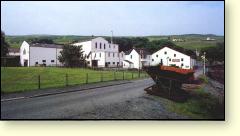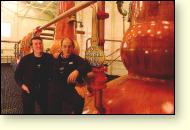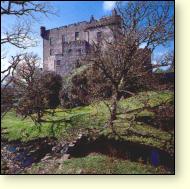
 |
|
Location: Carbost, Isle of Skye IV47 8SR
Roads: On B8009, via A850 and A863 from Sligachan
Hours: 9.30am - 4.30pm Mon - Fri (July - Aug. Mon - Sat)
Nov - March 2.00 - 4.30pm Mon - Fri
Group bookings by appointment
Reception centre, exibition and shop
Phone: 01478-640314
|
Text from The Whisky Trails, Copyright © Gordon Brown 1993:
Within sight of the famous Cuillin Mountains, Talisker distillery sits in the lee of its own hill on the shore of Loch Harport, the buildings pristine white between the vivid green of the slope behind and the slate-blue of the loch water lapping below. It is the hub of the tiny Gaelic-speaking crofting community of Carbost on the loch-side, yet, until recently, English was often heard at the distillery because – how could this be? – the distillery manager was an Englishman! He was also a member of the local mountain-rescue team.

The still house at Tallisker was re-built in the 1960s, with exact copies of the earlier stills to maintain the character of the spirit.
|
The distillery buildings are built round a central courtyard. The mysterious, pointed twin pagoda-head chimneys that rise above the roofs are vestiges of the old peat-fired ovens, which dried the locally produced malt and gave the whisky its wonderful, distinctively smoky aroma and flavour. Today the malt is peated elsewhere to Talisker’s specification, which lies somewhere between the lightness of the Highland malt whiskies on the mainland to the east, and the heaviness of the Islay malts to the south.
This is Clan Macleod territory and over half of the 14 distillery staff are Macleods. When a new lease was negotiated in the 1880s with the chief of the Clan, annual payment was to be £45, plus a 10-gallon cask of ‘best-quality’ Talisker (duty-free, of course) to be delivered at Michaelmas to Dunvegan Castle.
Talisker was built in 1831 by the MacAskill brothers from Eigg and named after their estate mansion just over the hill. Talisker House was traditionally the residence of the eldest son of the Macleod clan chief and over the centuries saw many distinguished guests. Just beside where the distillery now stands, Boswell and Johnson climbed on to their ponies for the journey over to the House. Sir Walter Scott also visited and Turner found time during a stay to paint Loch Coruisk in one of its more sombre moods.
One of the subsequent owners, J. Anderson, was jailed in 1880 for charging customers for whisky which, he told them, was safely maturing in the Talisker warehouses but which, in fact, did not exist. Talisker was later bought by a partnership, which included Roderick Kemp of Aberdeen who, when he later sold his share, went on to establish the Macallan distillery on Speyside. In 1898 Talisker merged with Dailuaine distillery, also on Speyside, and eventually, in 1925, both were acquired by DCL. In 1900 a pier and tramway were built, making the nightmarish difficulties of hoisting heavy, precious casks over the high side of a coaster from the water below a thing of the past. A dramatic fire in 1960 destroyed the still house, requiring the creation of five exact-copy stills; it must have been a nerve-wracking time during their first distillation-run as everyone waited to see if the nature of the spirit would turn out differently. There was no problem.
In the years prior to the distillery’s construction, the MacAskills had played their part in the Highland Clearances, evicting families to make way for Cheviot sheep; today, by contrast, several of the distillery’s staff are crofters and it is quite understood if someone has to slip away for an hour because a cow is calving or a hayrick has blown down.
Only the manager’s house, the offices and the warehouses are pre-1960 buildings. There used to be a waterwheel to supplement steam-engine power and in the 1920s the distillery was lit by acetylene gas lamps. The stills are great onion-shaped kettles, richly gleaming and radiating heat, with ever-narrowing swan-neck tops which gracefully lead their vapours away through the stillroom wall to cool and condense beyond. There are five stills at Talisker, two large ones for the first distillation and three smaller for the final. Their precise size and shape, even the angle at which the swan-neck lies, are vital to the continuing production of spirit with the authentic Talisker signature in aroma and flavour. Talisker used to be triple-distilled but now, like most Scotch malt whisky, it is double-distilled.
Talisker still has worm-pipes – rare in Scotland now – for condensing the vapour that runs off the stills. These spiral tubes of gradually diminishing calibre conduct the vapours down through wooden tubs of water kept constantly cold. Somewhere during the descent, the vapour condenses to liquid which is channelled off to spirit-receivers.
The water descends from Hawk Hill and is very peaty; the burns that run off the hills behind the distillery are rust-red in colour.
The Whisky
Text from The Whisky Trails, Copyright © Gordon Brown 1993:
Talisker is a highly distinctive whisky with a strong, smoky, peaty flavour because both the malt and the water used to make it are heavily peated. It has had a distinguished reputation for most of its existence and Robert Louis Stevenson described it as ‘king o’ drinks’ in an 1880 poem. Talisker is usually 45.8% vol. in strength and its optimum bottling age is now deemed to be 10 years. It was formerly bottled at eight years, however, and some very old vintages (1952, 1955) and a 14-year-old are also currently available from independent bottlers
Source of water
Cnoc-nan-Speireag
Of interest
Text from The Whisky Trails, Copyright © Gordon Brown 1993:

Dunvegan Castle, is the seat of the chiefs of the Clan Macleod.
|
• Dunvegan Castle is the oldest continuously inhabited castle in Britain. A lock of Bonnie Prince Charlie’s hair, clipped by Flora Macdonald, in its original locket is one of many interesting exhibits. There are white beaches, a seal colony and a shaggy-haired pedigree Highland cattle herd.
• Colbost Folk Museum near Dunvegan is a thatched crofthouse and has a richly aromatic peat fire burning most days; there is also a replica of an illicit still.
• The Clan Donald Centre at Armadale Castle, seat of the Macdonalds of Sleat, is a combination of clan heartland, Highland heritage exhibition and research centre. It is in a breathtaking coastal location and has 40 acres of restored 19th-century gardens and woodland trails, complete with a countryside ranger service. If you like it, you can stay over in one of the cottages there.
• In a room in the Royal Hotel in Portree, Bonnie Prince Charlie parted from Flora Macdonald after the Battle of Culloden to go into exile in France.
• Trail End is really at Kyle of Lochalsh where the car ferry (soon it will be an ugly, bargain-basement bridge) takes you back to the mainland. However, why not close the trail just a little further on down the road from Kyle of Lochalsh at Eilean Donan Castle, perched on an islet at the junction of three lochs - Long, Duich and Alsh? It is a beautiful spot, perhaps the most photographed castle in Scotland, and deservedly so.